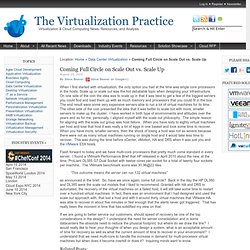

Coming Full Circle on Scale Out vs. Scale Up. When I first started with virtualization, the only option you had at the time was single core processors in the hosts.

Scale up or scale out was the hot debatable topic when designing your infrastructure. On one side of the coin the idea was to scale up in that it was best to get a few of the biggest servers you could find and load them up with as much memory and processors that you could fit in the box. The end result were some very expensive servers able to run a lot of virtual machines for its time. The other side of the coin presented the idea that it was better to scale out with more, smaller servers to make up the cluster. I have worked in both type of environments and attitudes over the years and as for me, personally, I aligned myself with the scale out philosophy. Flash forward to today and we have multi-core processors that pretty much come standard in every server.
“This outcome means the server can run 132 virtual machines” as announced in the brief. Steve Beaver (141 Posts) Scale Up vs. Scale Out. For years I've had the discussion with developers, database administrators, and system admins on big-box vs. the multi-box solutions.

The question is "How is scalability achieved"? Application scalability can be defined as the ability to increase the application throughput in proportion to the hardware that is being used to host the application. In other words, if an application is able to handle 100 users on a single CPU hardware, then the application should on be able to handle 200 users when the number of process are doubled. Vertical scalability is adding more memory and CPUs to a single box, or scaling up. Vertical scalability or scaling up is well suited for database tier.
Large shared memory space, Many dependent threads, Tightly-coupled internal interconnect Horizontal scalability is adding more boxes of similar memory and CPU, or scaling out. Small non-shared memory spaceMany independent threadsLoosely-coupled external interconnect [an important point]Possibly many OS's. Pagefile Optimization. By Daniel Petri - January 8, 2009 How can I optimize the Windows 2000/XP/2003 virtual memory (Pagefile)?

Memory tweaking is an important part of the System Administrator's responsibilities. Having too much memory won't hurt you, but this is something we cannot expect to have all the time. This page will give you some working tips on memory management for Windows 2000, Windows XP and Windows Server 2003. Warning: Before you start working with these tips you should read my Before you begin page. Thanks to reader Perris Calderon for the heads-up on some needed fixes on this page (3/02/2003) Parts of this page have information taken from MS MVP Alex Nichol's excellent article about XP Virtual Memory found HERE. What is Virtual Memory? In a 32-bit computer, the memory addresses are 32 bits long and stored as binary (base 2) numbers. A program instruction on an Intel 386 or later CPU can address up to 4GB of memory, using its full 32 bits.
This is normally far more than the RAM of the machine.